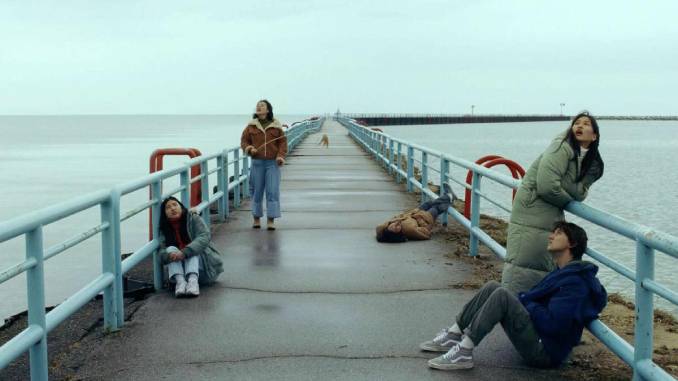Generation Z Has Its Quarter-Life Crisis in Waiting for the Light to Change

“I still feel like a kid. I’m 25 and I haven’t done shit… feels like I’m wasting my entire life.”
If you’ve had the extraordinary privilege of being a Gen Z’er who entered their early 20s amidst the soul-crushing pandemic, there’s a good chance that you or someone in your immediate circle of friends has echoed this very sentiment at some point in the last three years. If these words have ever left your mouth—or if you’re prone to bouts of melancholy and struggle with finding a sense of direction in life—you probably have a lot in common with the young protagonists at the center of Linh Tran’s slow-burning feature debut, Waiting for the Light to Change.
In Waiting for the Light to Change, Amy (Jin Park) is an aimless 25-year-old with no clear sense of purpose. Lin (Qun Chi) is a newly single international student still very much in love with her ex. Jay (Sam Straley) is a recently unemployed cook grappling with the loss of his father. Kim (Joyce Ha) is an outwardly successful young woman with a cute boyfriend and promising career. And Alex (Erik Barrientos) is the friend with a man-bun and seemingly never-ending supply of marijuana. When these five characters—some combination of relatives, lovers, school friends, and complete strangers to each other—come together for a week-long getaway at a scenic Michigan lake house, they find themselves dealing with the difficulties that seem to haunt one’s early-to-mid 20s: Mourning the naïve childhood expectations of adulthood, finding a fulfilling career, harping over the things you should have done differently and experiencing unhealthy amounts of anxiety around what the future might hold.
Of the film’s many striking elements, including its remarkably slow pace and pastel-colored cinematography, what leaves the biggest impression is Tran’s poetic use of setting to establish Waiting for the Light to Change’s somber tone and typify the internal struggles of her subjects. It’s the conclusion of a cold midwestern winter and the lakeside home in which the group inhabits has chilled over with a quiet sense of dread. The gloomy weather has sent other vacationers home. The off-season offers virtually no recreational fun to be had, and the beautiful blue waters that surround the property are much too cold to touch, let alone swim in. There’s just so much they can’t do in this weather, so they resort to taking drugs, dwelling on past regrets and having depressing conversations along the chilly shore.
In Waiting for the Light to Change, a setting that would otherwise be brimming with opportunity and excitement in the warm summer months instead becomes a place of limitation, a constant reminder that there is warmth to be felt, success to be had, laughter to be shared…just not for you. Not in this season. Here, the quarter-life crisis manifests in the freezing lake house: A physical representation of what it feels like to watch your youth and future slip just beyond your reach. It’s isolation. It’s wasted potential. It’s waiting for a brighter season that feels like it’ll never arrive.
-

-

-

-

-

-

-

-

-

-

-

-

-

-

-

-

-

-

-

-

-

-

-

-

-

-

-

-

-

-

-

-

-

-

-

-

-

-

-

-








































